
|
Chandragupta II was succeeded by his son Kumaragupta, whose earliest known date is (Gupta era) 96 (=416 CE). His reign was peaceful, except at the very end
when he faced rebellion in his western provinces, which his son Skandagupta was dispatched to suppress. Kumaragupta reigned c. 415-455. His gold coins are considered
some of the finest examples of Indian numismatic art. He also issued a large silver coinage, some very rare coins in copper and also coins in lead.
|
| Gold Coins |
Archer type |
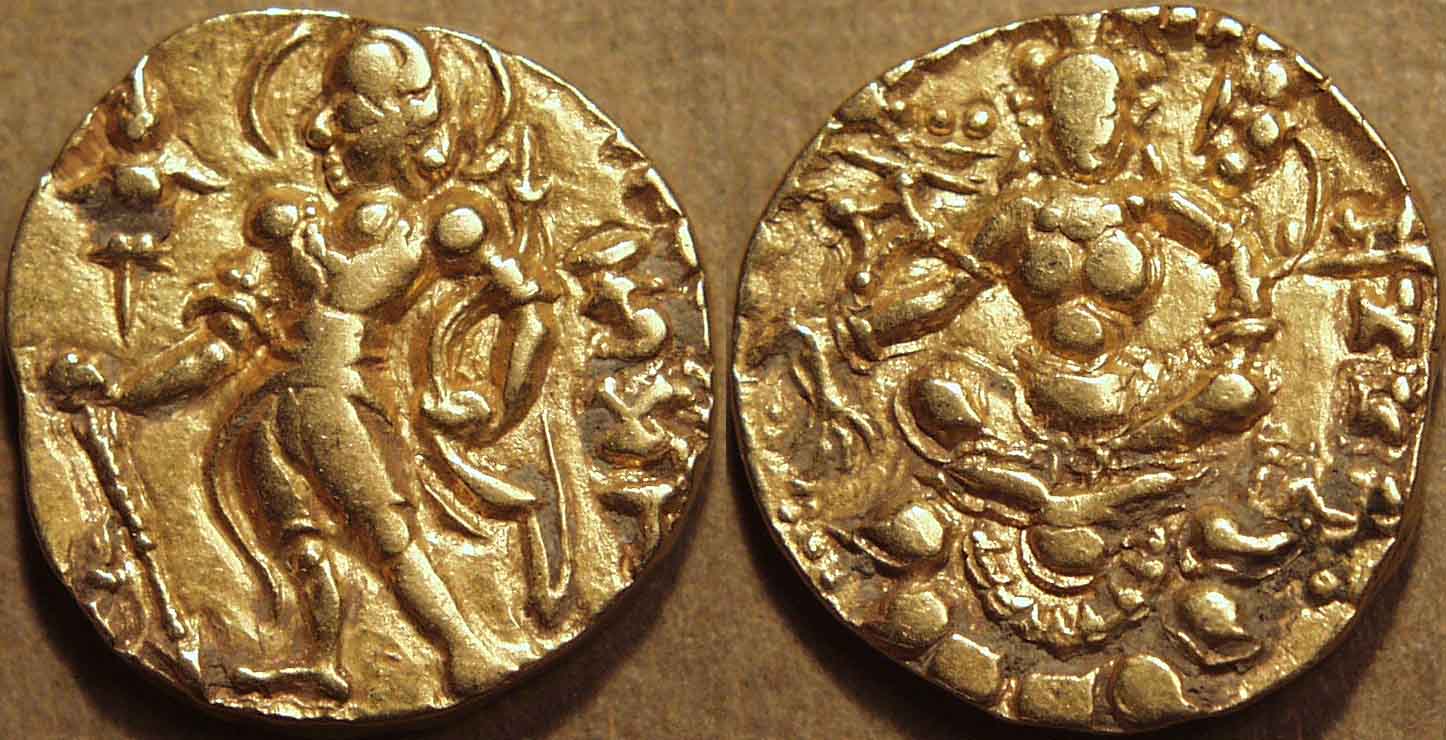
|
Kumaragupta I, gold dinar, c. 415-455
Weight: 7.85 gm, Diameter: 18 mm.
King standing left, holding an Indian long bow in his left hand and an arrow in his right
Garuda standard at left, Brāhmī legend in right field: Kumāra
circular Brāhmī legend around /
Lakshmi seated facing, holding long-stemmed lotus and scattering coins with her right hand,
Brāhmī legend at right: Sri Mahendra
|
 |
Kumaragupta's archer type comes in several varieties; on this one, the king holds the bow with the bowstring facing out.
|

|
Kumaragupta I, gold dinar, c. 415-455
Weight: 8.21 gm, Diameter: 19 mm.
King standing left, holding an Indian long bow in his left hand and an arrow in his right
Garuda standard at left, Brāhmī legend under arm: Ku
circular Brāhmī legend around /
Lakshmi seated facing, holding long-stemmed lotus and diadem,
Brāhmī legend at right: Sri Mahendra
|
 |
On this variety, the king holds the bow in the more "normal" position with the bowstring facing in. The legend
Kumāra in the right field has been replaced by a simple Ku under the king's arm.
|

|
Kumaragupta I, gold dinar, c. 415-455
Weight: 8.17 gm, Diameter: 19 mm.
King standing left, holding an Indian long bow in his left hand and an arrow in his right
Garuda standard at left, Brāhmī legend under arm: Ku
circular Brāhmī legend around /
Lakshmi seated facing, holding long-stemmed lotus and scattering coins
with her right hand, Brāhmī legend at right: Sri Mahendra
|
 |
Here the goddess on the reverse no longer holds a diadem in her right hand; instead, she is scattering coins with it ... a
representation of Lakshmi that persists to this day.
|
 |
 |
 |
Horseman type |
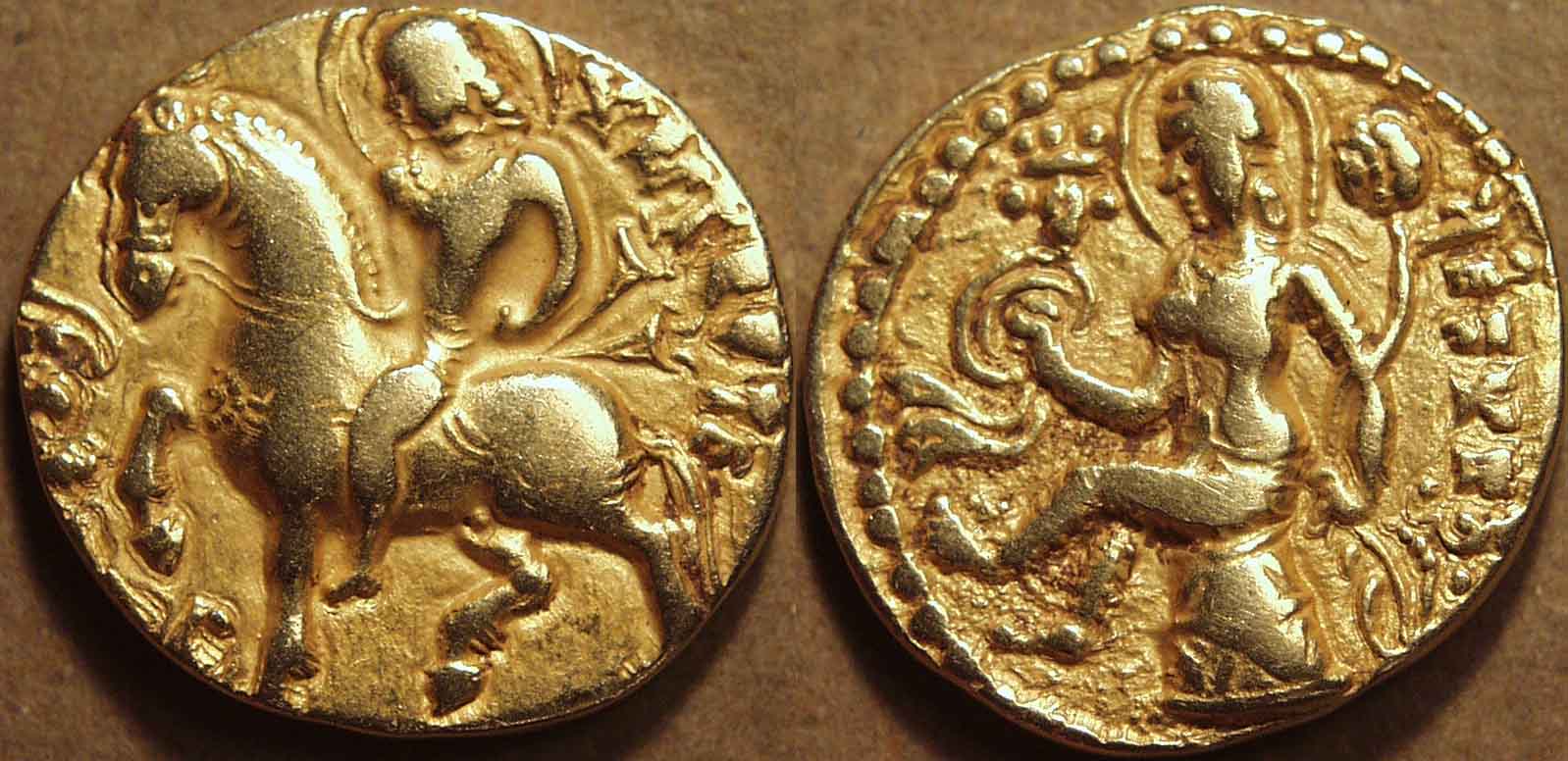
|
Kumaragupta I, gold dinar, c. 415-455
Weight: 8.25 gm, Diameter: 21-20 mm.
King riding horse left,
circular Brāhmī legend around /
Lakshmi seated left on stool, holding diadem and long-stemmed lotus
Brāhmī legend at right: Ajitamahendrah
|
 |
The horseman types of Kumaragupta, like those of Chandragupta II, come with the king facing either left or right. Also,
the reverses vary by whether Lakshmi is holding a diadem or feeding a peacock.
|
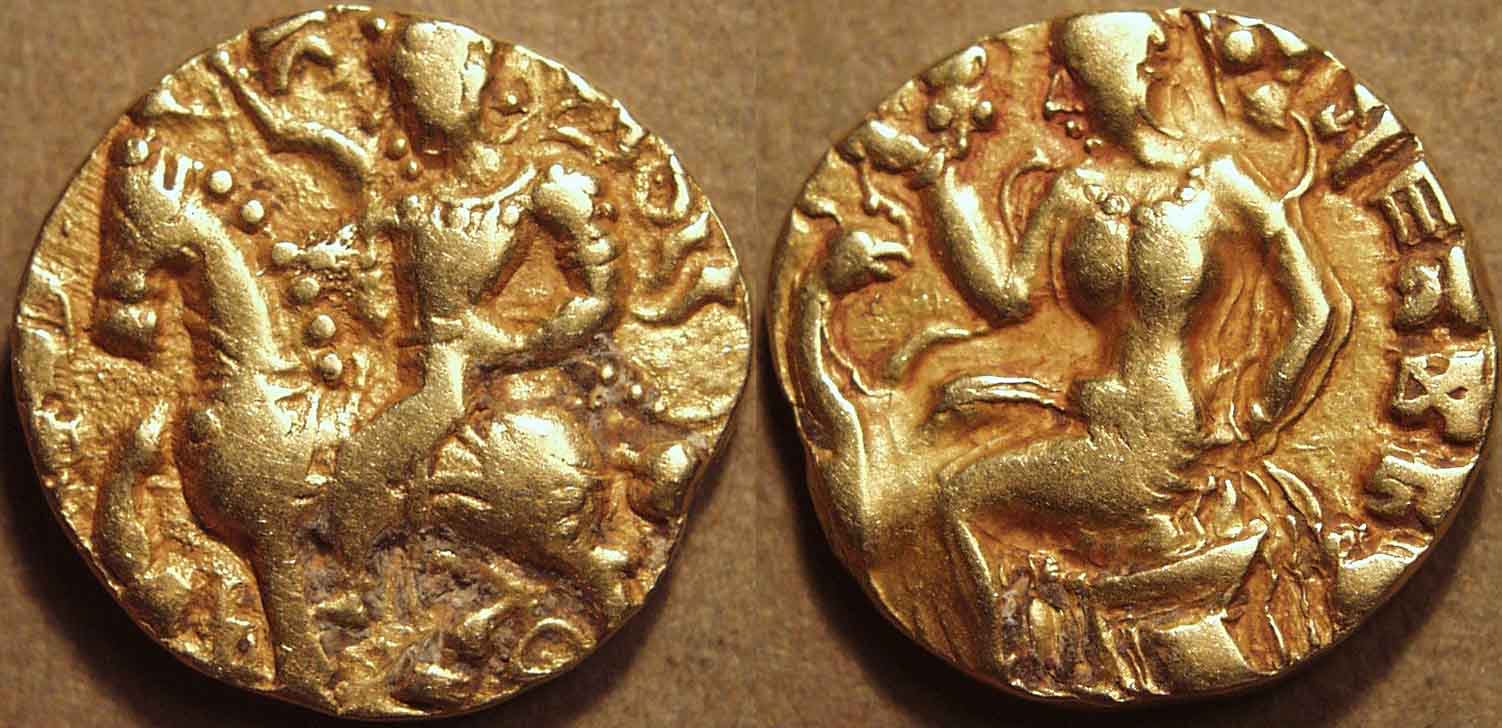
|
Kumaragupta I, gold dinar, c. 415-455
Weight: 8.11 gm, Diameter: 20 mm.
King riding horse left, holding bow in right hand,
circular Brāhmī legend around /
Lakshmi seated left on stool, holding diadem and feeding a peacock at left
Brāhmī legend at right: Ajitamahendrah
|
 |
Here the king is holding a bow as he rides his horse and Lakshmi is feeding a peacock. The artistic quality of the
rendering of the peacock is astonishing, with its prominent mouth and, particularly, the palpably suppple neck that calls to my mind the peacock in an extraordinary miniature
painting of the Mughal painter Mansur.
|
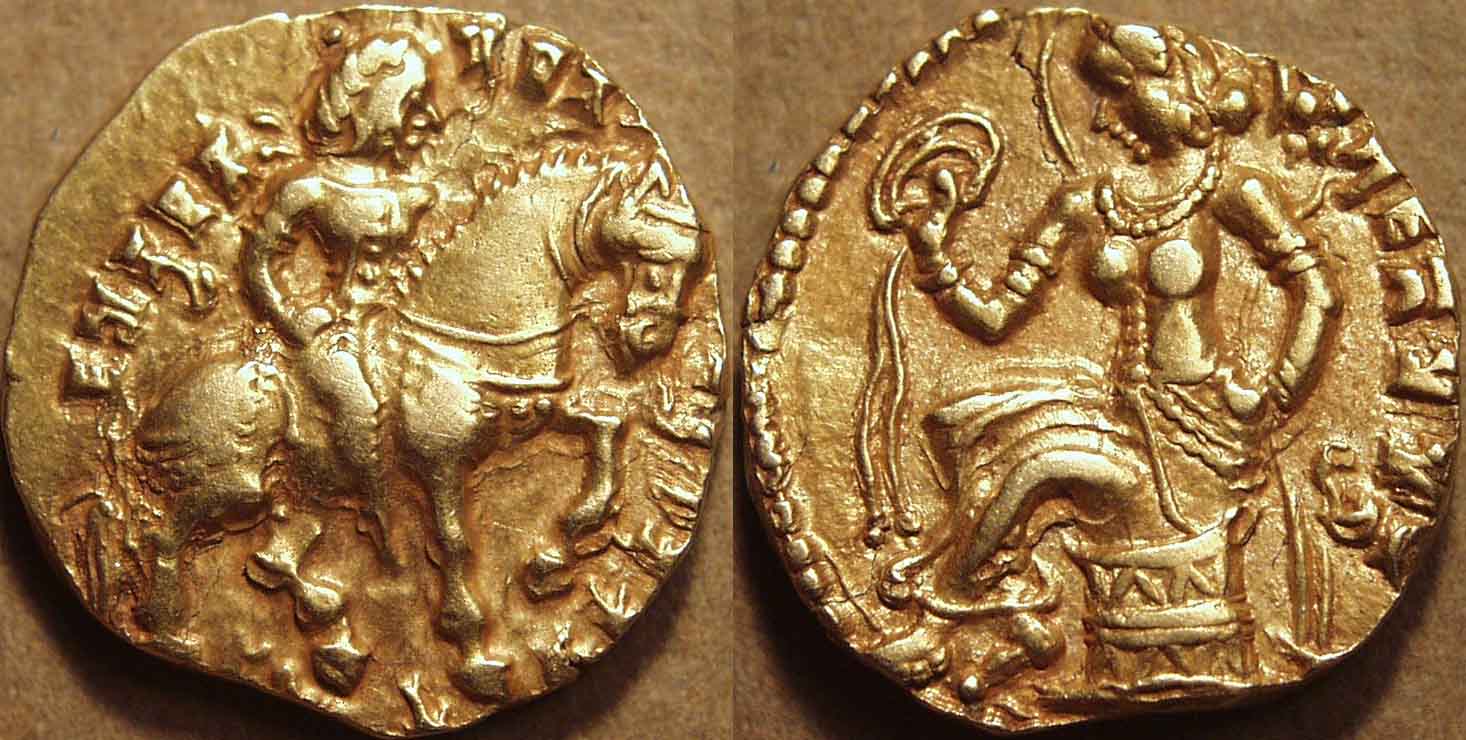
|
Kumaragupta I, gold dinar, c. 415-455
Weight: 8.16 gm, Diameter: 19 mm.
King riding horse right,
circular Brāhmī legend around /
Lakshmi seated left on stool, holding diadem and long-stemmed lotus
Brāhmī legend at right: Ajitamahendra
|
 |
Here the mounted king faces right. Note the extraordinarily beautiful rendition of Lakshmi on this coin. It is artistic coins
like this one that inspire observers to rate Kumaragupta's coins as the artistic peaks of ancient Indian numismatics.
|
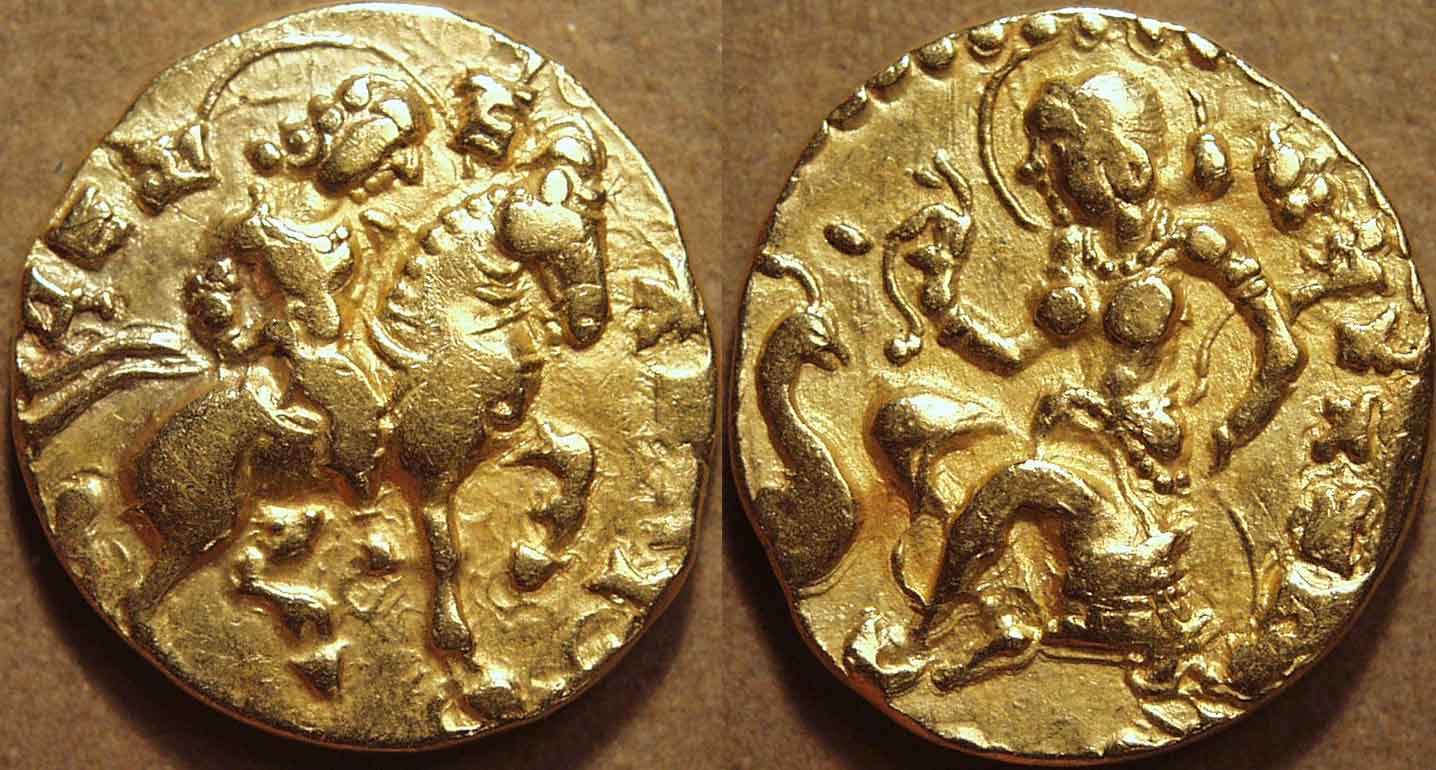
|
Kumaragupta I, gold dinar, c. 415-455
Weight: 8.08 gm, Diameter: 19 mm.
King riding horse right,
circular Brāhmī legend around /
Lakshmi seated left on stool, holding lotus and feeding a peacock at left
Brāhmī legend at right: Ajitamahendrah
|
 |
The basic type with mounted king right and Lakshmi feeding a peacock.
|
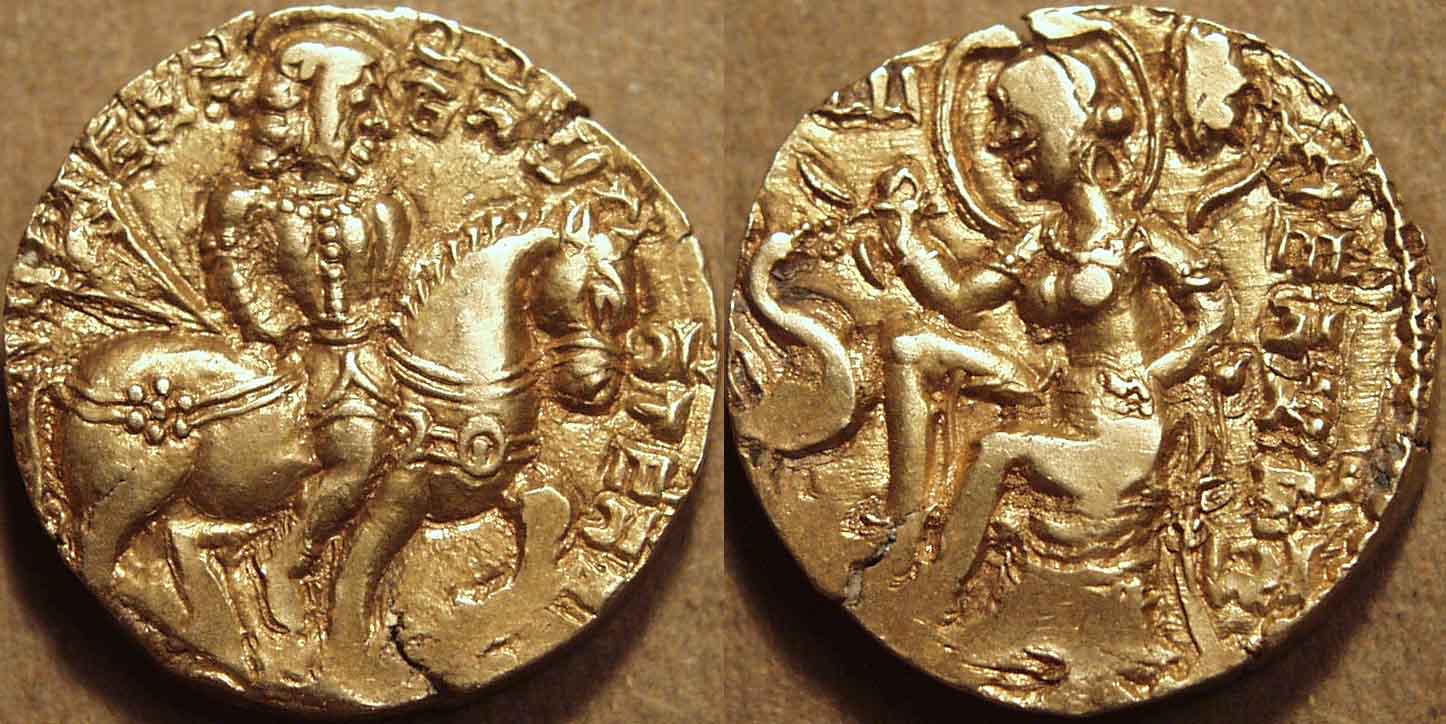
|
Kumaragupta I, gold dinar, c. 415-455
Weight: 8.32 gm, Diameter: 19 mm.
King riding horse right,
circular Brāhmī legend around /
Lakshmi seated left on stool, holding lotus and feeding a peacock at left
Brāhmī legend at right: Ajitamahendrah
|
 |
A variety of the previous type in which the horse is richly caparisoned..
|
 |
 |
 |
Lion-slayer type |
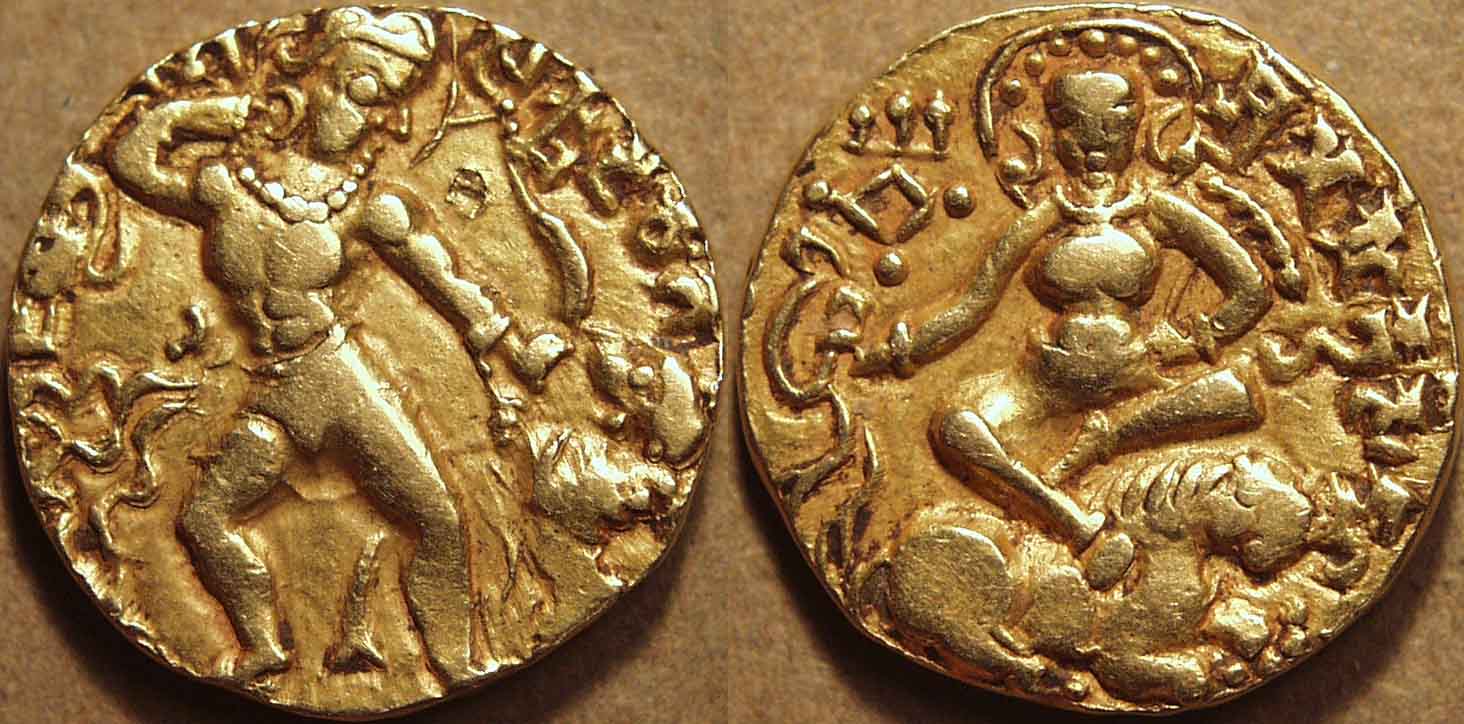
|
Kumaragupta I, gold dinar, c. 415-455
Weight: 8.21 gm, Diameter: 19 mm.
King standing right, shooting arrow at lion at right,
circular Brāhmī legend around /
Lakshmi (Durga?) seated facing on couchant lion right, holding diadem and cornucopia
Brāhmī legend at right: Sri Mahendrasimha
|
 |
Note how Lakshmi holds a stylized cornucopia rather than a lotus in her left arm, like in the early archer types. The
presence of the cornucopia here suggests this might be a mint marker rather than a chronological one.
|
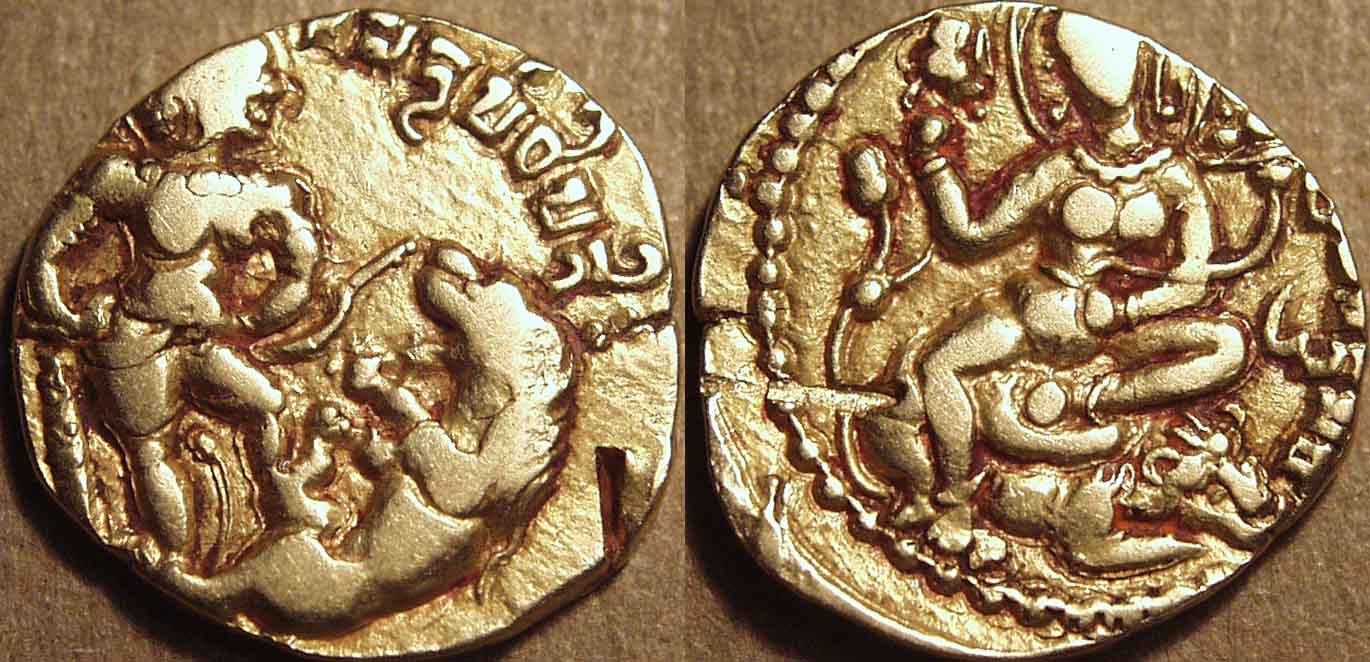
|
Kumaragupta I, gold dinar, c. 415-455
Weight: 8.27 gm, Diameter: 19 mm.
King standing right, trampling lion at right,
circular Brāhmī legend around /
Lakshmi (Durga?) seated facing on couchant lion right, holding a lotus blossom in each hand
Brāhmī legend at right: Sri Mahendrasimha
|
 |
Here the cornucopia has disappeared, and so has the diadem ... Lakshmi holds a lotus blossom in each hand, and her
right hand is raised up.
|

|
Kumaragupta I, gold dinar, c. 415-455
Weight: 8.16 gm, Diameter: 19 mm.
King standing right, shooting arrow at lion at right,
circular Brāhmī legend around /
Lakshmi (Durga?) seated facing on couchant lion right, holding diadem ? and
long-stemmed lotus, Brāhmī legend at right: Simhamahendra
|
 |
Here Lakshmi holds a lotus in her left hand, but the object in her right hand is not entirely clear; she may be scattering
coins with it. Also, the biruda on the reverse now reads Simhamahendra instead of Sri Mahendrasimha.
|

|
Kumaragupta I, gold dinar, c. 415-455
Weight: 7.69 gm, Diameter: 20 mm.
King standing right, shooting arrow at lion at right,
circular Brāhmī legend around /
Lakshmi (Durga?) seated facing on couchant lion right, holding long-stemmed lotus and
scattering coins with her right hand, Brāhmī legend at right: Simhamahendra
|
 |
On this variety, Lakshmi appears to be scattering coins with her right hand.
|
 |
 |
 |
Tiger-slayer type |

|
Kumaragupta I, gold dinar, c. 415-455
Weight: 8.07 gm, Diameter: 19 mm.
King standing left, shooting arrow at tiger at left,
Brāhmī Ku under arm, circular Brāhmī legend around /
Goddess Ganga standing left on makara, holding long-stemmed lotus in left hand,
right hand outstretched, feeding peacock at left,
Brāhmī legend at right: Kumaraguptodhiraja
|
 |
With the tiger-slayer type, Kumaragupta revives a type issued by Samudragupta but apparently excluded by
Chandragupta II. The tiger-slayer type can be distinguished from the lion-slayer type in two ways. First, most important, the obverse legend contains the word vyaghra,
Sanskrit for "tiger" (the obverse legend here reads vyaghrabalaparakrama). That is of course the real way in which numismatists figured out that the animal shown is
meant to be a tiger. Second, the reverse deity on all the tiger-slayer coins (of Kumaragupta as well as Samudragupta) is not Lakshmi but Ganga, reflecting the tiger's
preference for wetland habitats. Ganga is always shown standing on a makara, a mythical animal resembling a crocodile (befitting a riverine goddess) but with an
elephant-like trunk.
|
 |
 |
 |
Rhinoceros-slayer type |
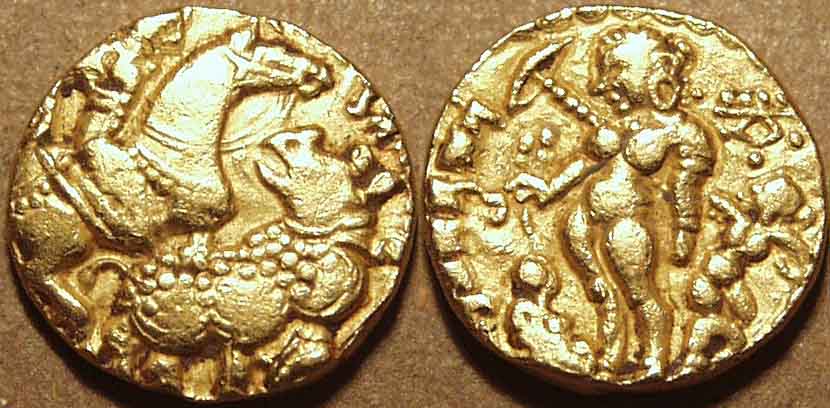
|
Kumaragupta I, gold dinar, c. 415-455
King on horseback right, holding sword in right hand,
attacking rhinoceros right but with head turned back,
circular Brāhmī legend around /
Goddess Ganga standing left on makara, holding lotus in right hand,
attendant at right holding parasol aloft
Brāhmī legend at left: Sri Mahendrakhadga
|
 |
An amazing new type introduced by Kumaragupta. The composition of the obverse and particularly the rendition of the
rhinoceros, with its scaly skin and the look of alarmed fear on its face, are of the highest artistic quality.
|
 |
 |
 |
Elephant-rider type |
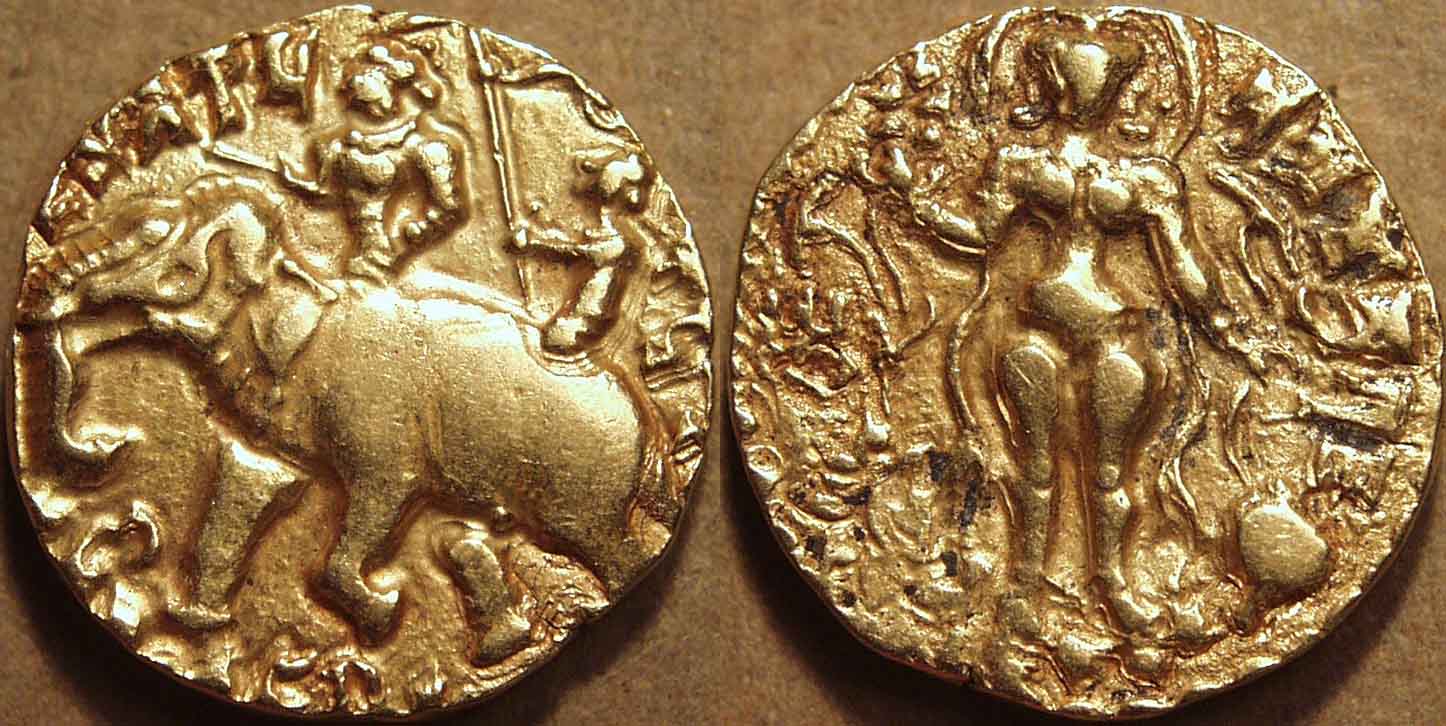
|
Kumaragupta I, gold dinar, c. 415-455
Weight: 8.09 gm, Diameter: 19 mm.
King on elephant left, holding goad in right hand,
attendant seated behind, holding up parasol,
circular Brāhmī legend around /
Lakshmi standing facing on a lotus, holding lotus in right hand,
and cornucopia in left hand, additional lotus in left field
and sankh (conch) in right field,
Brāhmī legend at right: Sri Mahendragajah
|
 |
The elephant-rider type may have been inspired by the similar types of the Kushan king Huvishka, whose most common
bronze coins showed the emperor riding on an elephant, but who also issued such coins in gold. The image of the king riding an elephant remained a powerful representation of
royalty into the Mughal period and later.
|

|
Kumaragupta I, gold dinar, c. 415-455
Weight: 7.61 gm, Diameter: 19 mm.
King on elephant right, holding dagger in right hand,
attendant seated behind, holding up parasol,
elephant trampling lion underfoot,
circular Brāhmī legend around /
Lakshmi standing right but facing left, holding out right hand
as if to pet peacock standing at left
Brāhmī legend at left and right: Sinhanihanta Mahendragajah
|
 |
On this version of the elephant-rider type, the king is shown lion hunting, holding up a dagger to fling at the lion, which is
being trampled by the elephant. The whole effect is very dynamic.
|
 |
 |
 |
Swordsman type |
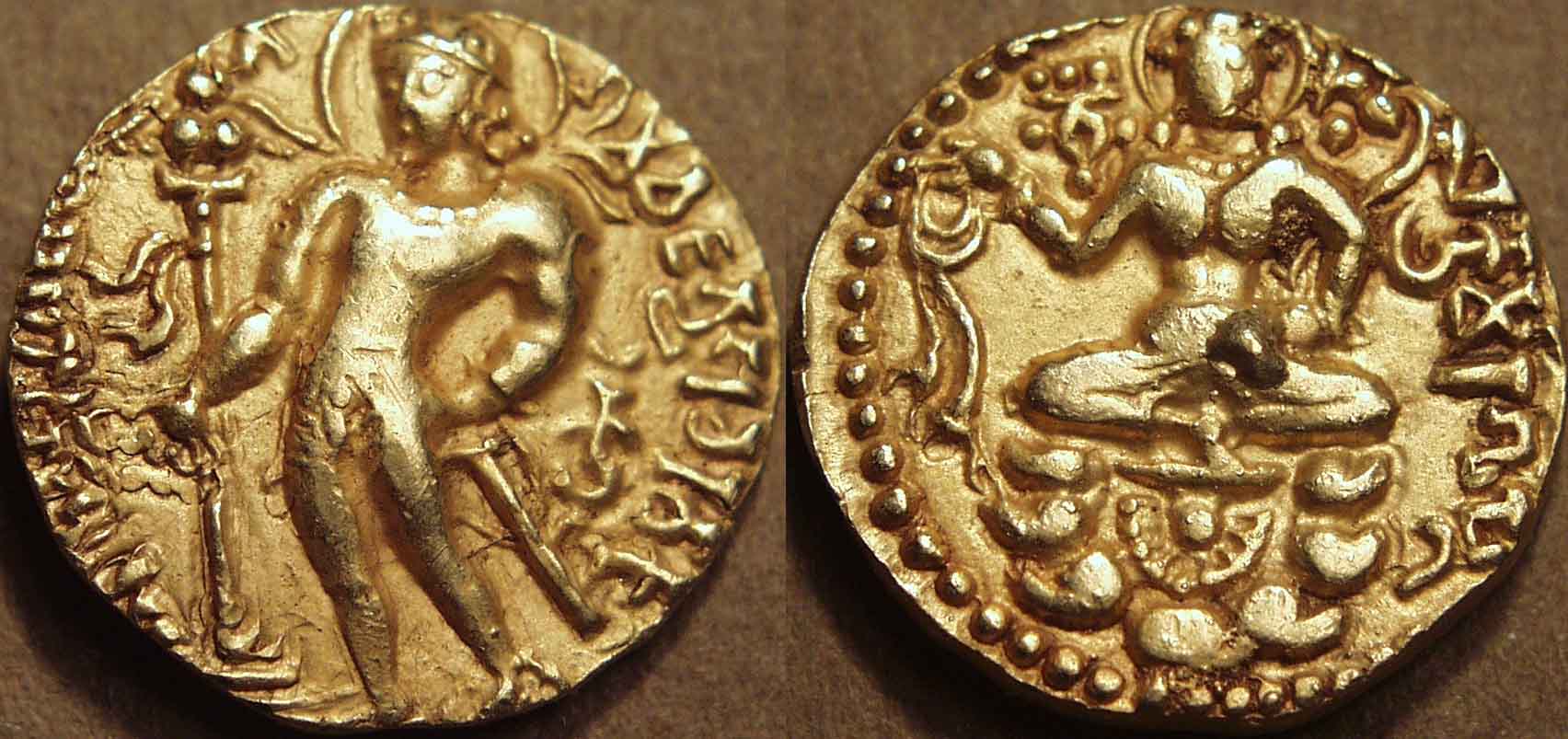
|
Kumaragupta I, gold dinar, c. 415-455
Weight: 8.08 gm, Diameter: 20 mm.
King standing facing, holding sword hilt with left hand,
making an offering with the right hand,
Garuda standard at left, Brāhmī Ku under arm,
circular Brāhmī legend around /
Lakshmi seated facing on a lotus, holding diadem and lotus,
Brāhmī legend at right: Sri Kumaragupta
|
 |
The swordsman type is unique to Kumaragupta.
|
 |
 |
 |
Karttikeya type |
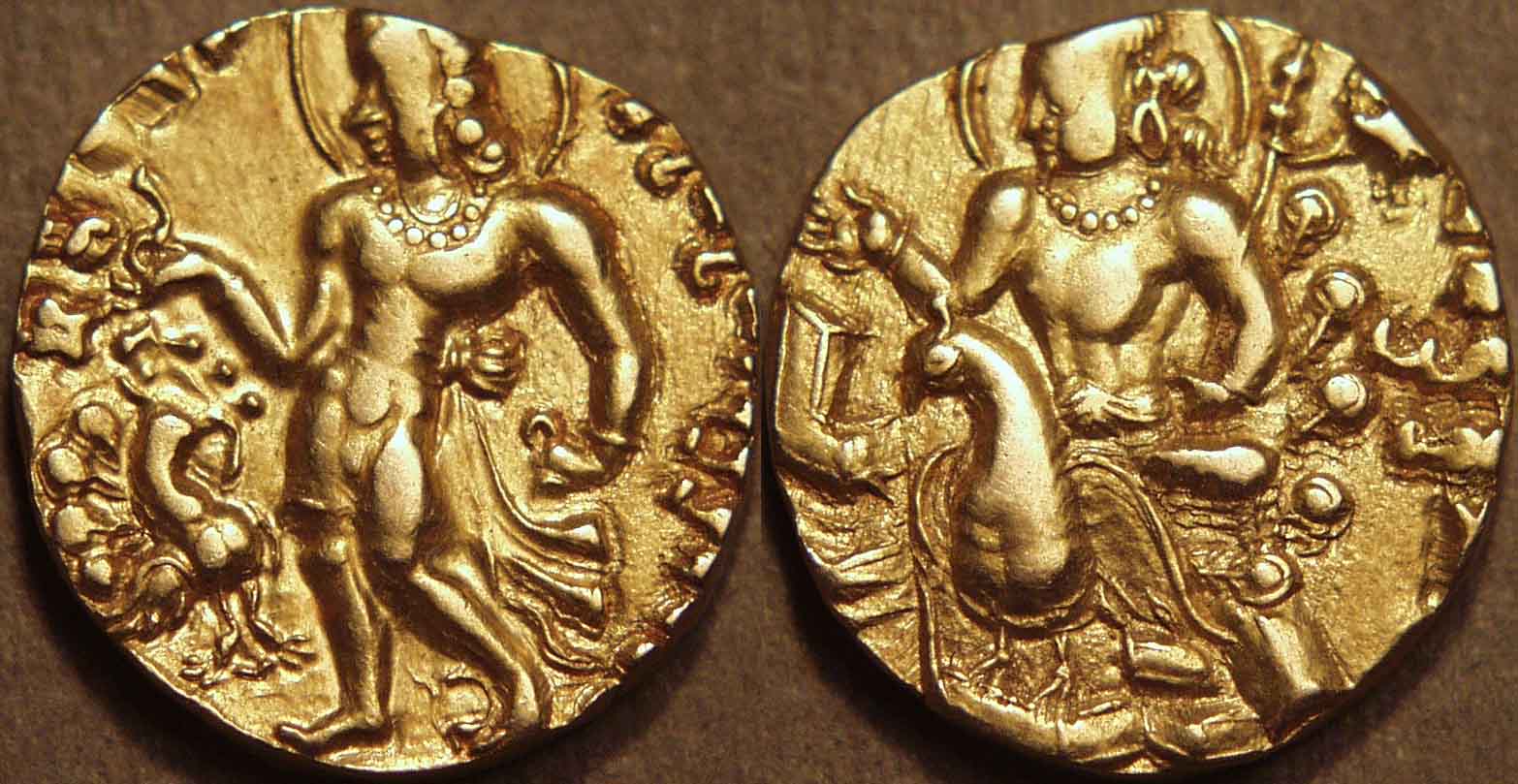
|
Kumaragupta I, gold dinar, c. 415-455
Weight: 8.27 gm, Diameter: 19 mm.
King standing left, offering grapes to peacock at left,
circular Brāhmī legend around /
Karttikeya seated slightly left on a peacock,
holding spear with left hand, right hand outstretched,
Brāhmī legend at right: Mahendrakumarah
|
 |
Kumaragupta must have felt an affinity to Karttikeya, the son of Shiva who was also called Kumara. This type is also unique
to Kumaragupta.
|
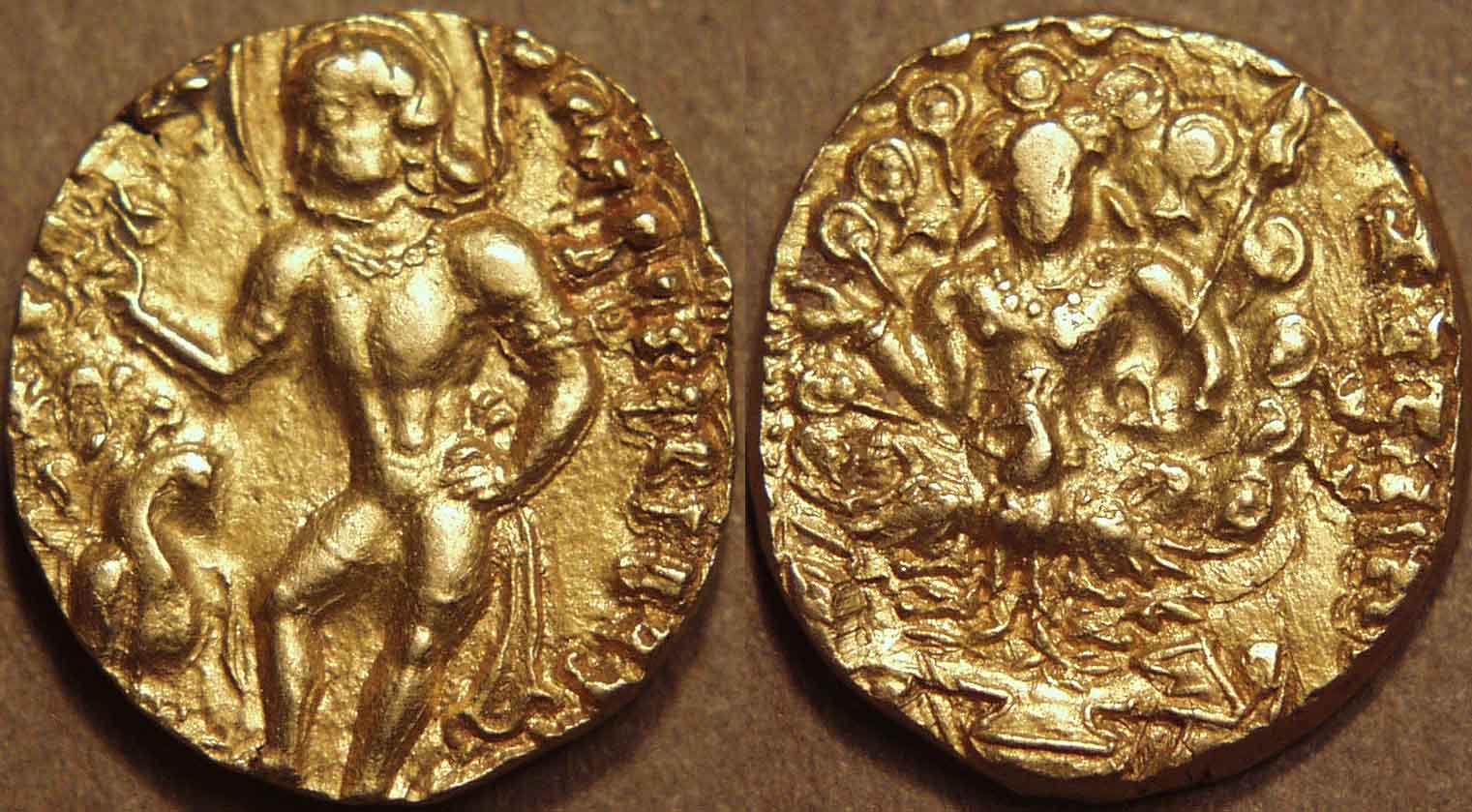
|
Kumaragupta I, gold dinar, c. 415-455
Weight: 8.30 gm, Diameter: 18-20 mm.
King standing left, left hand on hip, right hand out-stretched,
peacock standing at left,
circular Brāhmī legend around /
Karttikeya seated facing on a peacock,
holding spear with left hand, right hand outstretched, scattering coins,
Brāhmī legend at right: Mahendrakumarah
|
 |
On this variety, Karttikeya is seen more frontally on the reverse, and the king is holding his right hand far above the head of
the peacock.
|
 |
 |
 |
Apratigha type |
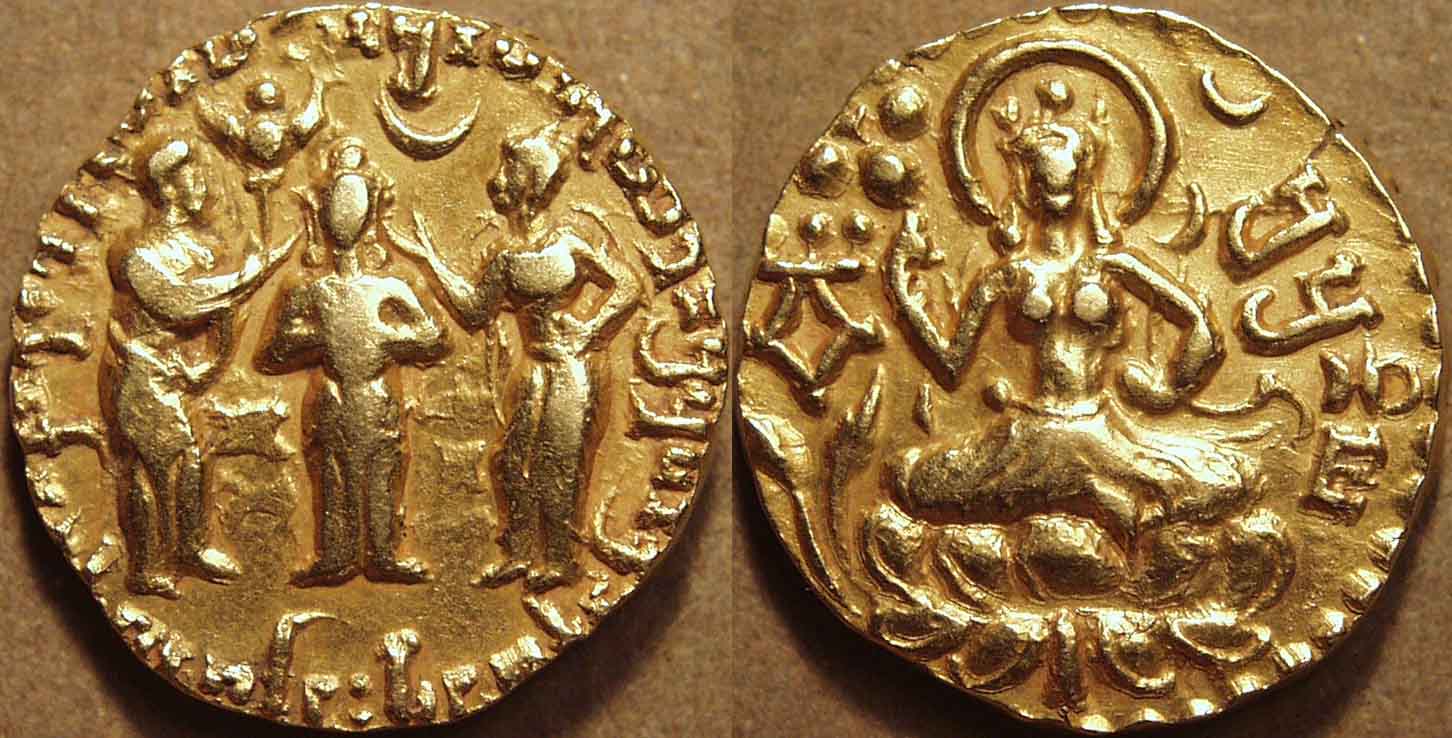
|
Kumaragupta I, gold dinar, c. 415-455
Weight: 7.90 gm, Diameter: 19 mm.
King standing facing, flanked by figures at left and right,
Brāhmī legend next to king: Kumara / gupta
Garuda standard at left, crescent at right,
circular Brāhmī legend around /
Lakshmi seated facing on a lotus,
holding lotus in right hand, crescent-topped tendril in left,
Brāhmī legend at right: Apratigha
|
 |
This is the most enigmatic Gupta coin, as no one has yet successfully explained its significance. The obverse circular
legend is still unread. But, most important, we do not know the identities of the two figures flanking the king. We know the central figure is the king, as his name is written in two
lines on either side of him. But who are the other two, and what are they doing? Altekar has suggested that they may be the queen and crown prince, trying to persuade the king
not to follow through on his decision of renunciation (as suggested by his wearing no jewelry and placing his hair in a top-knot). But their entreaties are not successful, as the king
is apratigha, invincible. On the other hand, Raven has challenged this explanation, pointing out that the king is wearing jewelry. She suggests he is the
young Kumara (crownprince) being offered the Garuda banner at the commencement of his rule. Thus, while Altekar suggests it is a coin commemorating the end of
Kumaragupta's reign, Raven suggests it marks the beginning of the reign.
|
 |
 |
 |
Lyrist type |
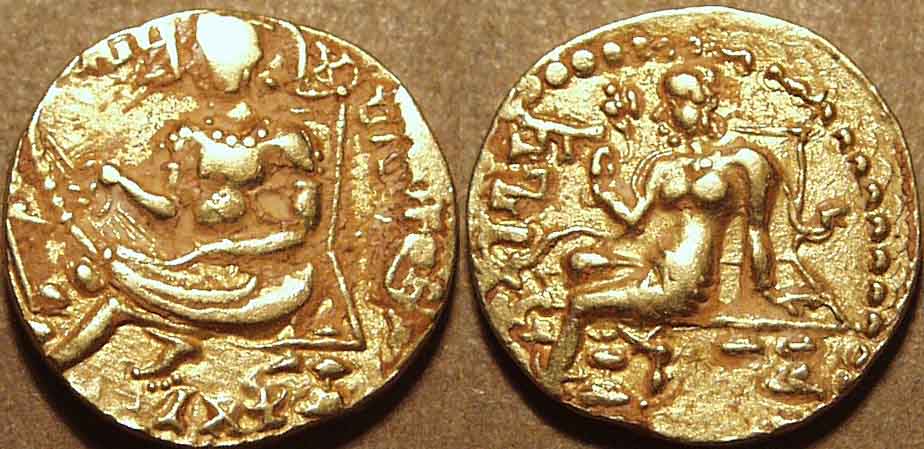
|
Kumaragupta I, gold dinar, c. 415-455
King seated left on a couch, playing the vina
circular Brāhmī legend around /
Queen seated left on a couch, leaning on her left hand,
and holding a lotus in her right hand,
Brāhmī legend at left: Kumaragupta
|
 |
Like the tiger-slayer type, this coin type is a revival of a Samudragupta coin type.
|
 |
 |
| Silver Coins |
Western type |
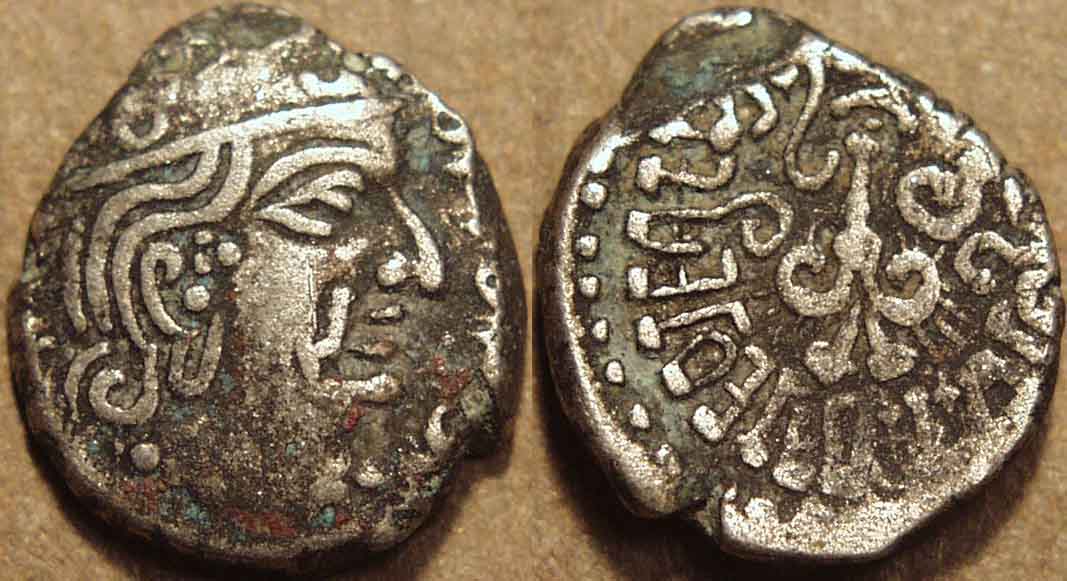
|
Kumaragupta I, silver drachma, c. 415-455
Weight: 1.92 gm, Diameter: 12-14 mm.
Head of king right /
Stylized Garuda standing facing, with wings spread,
Brāhmī legend around:
Paramabhāgavata Rajadhiraja Sri Kumaragupta Mahendraditya
|
 |
The Western type of silver coins of Kumaragupta are based on Western Kshatrapa prototypes. The two major variations
differ on whether the king is referred to as Rajadhiraja, as on this coin, or as Maharajadhiraja, as on subsequent coins.
|
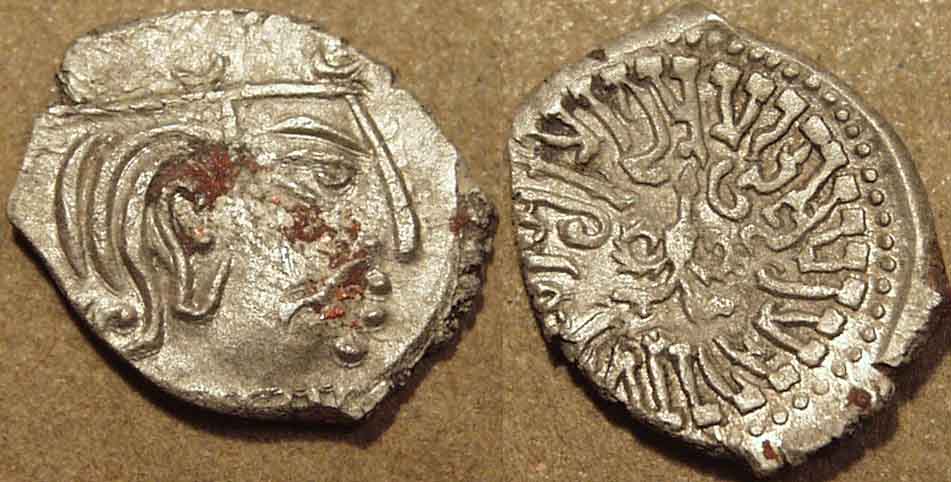
|
Kumaragupta I, silver drachma, c. 415-455
Weight: 1.82 gm, Diameter: 15-13 mm.
Head of king right /
Stylized Garuda standing facing, with wings spread,
Brāhmī legend around:
Paramabhāgavata Maharajadhiraja Sri Kumaragupta Mahendraditya
|
 |
This coin features the Maharajadhiraja legend.
|
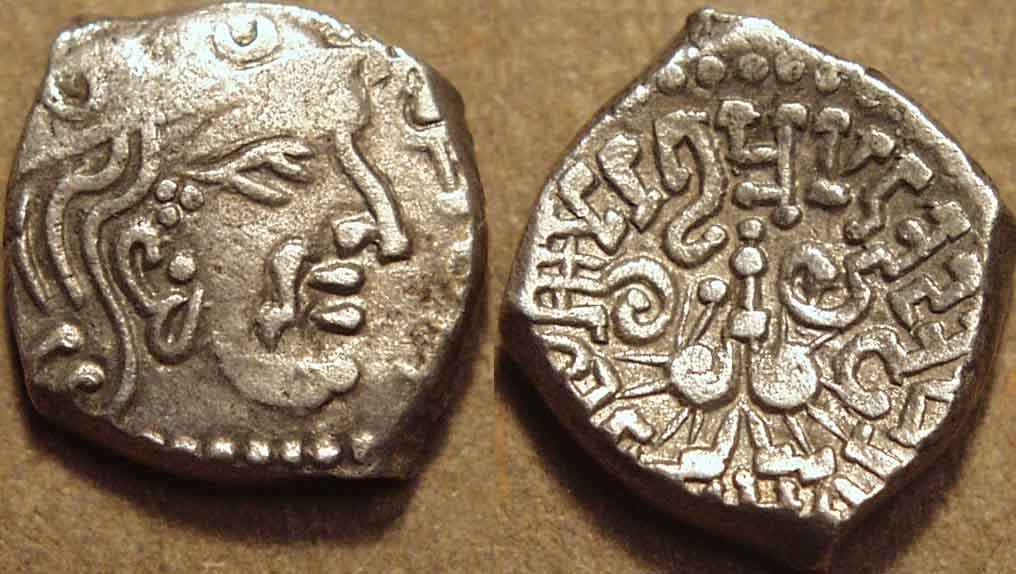
|
Kumaragupta I, silver drachma, c. 415-455
Weight: 2.08 gm, Diameter: 12 mm.
Head of king right /
Stylized Garuda standing facing, with wings spread,
Brāhmī legend around:
Paramabhāgavata Maharajadhiraja Sri Kumaragupta Mahendraditya
|
 |
This coin features a very different portrait style.
|

|
Kumaragupta I, silver drachma, c. 415-455
Weight: 2.21 gm, Diameter: 14 mm.
Head of king right /
Stylized Garuda standing facing, with wings spread, sun above right,
Brāhmī legend around:
Paramabhāgavata Maharajadhiraja Sri Kumaragupta Mahendraditya
|
 |
On this coin, the stylized sun present on all Kshatrapa coins makes a reappearance. The representation of Garuda is
quite different; also notice the elegant calligraphy of the legend.
|

|
Kumaragupta I, silver drachma, c. 415-455
Weight: 2.19 gm, Diameter: 14-13 mm.
Head of king right /
Stylized Garuda standing facing, with wings spread, sun above right,
Brāhmī legend around:
Paramabhāgavata Maharajadhiraja Sri Kumaragupta Mahendraditya
|
 |
Highly stylized portrait of the king and representation of Garuda.
|
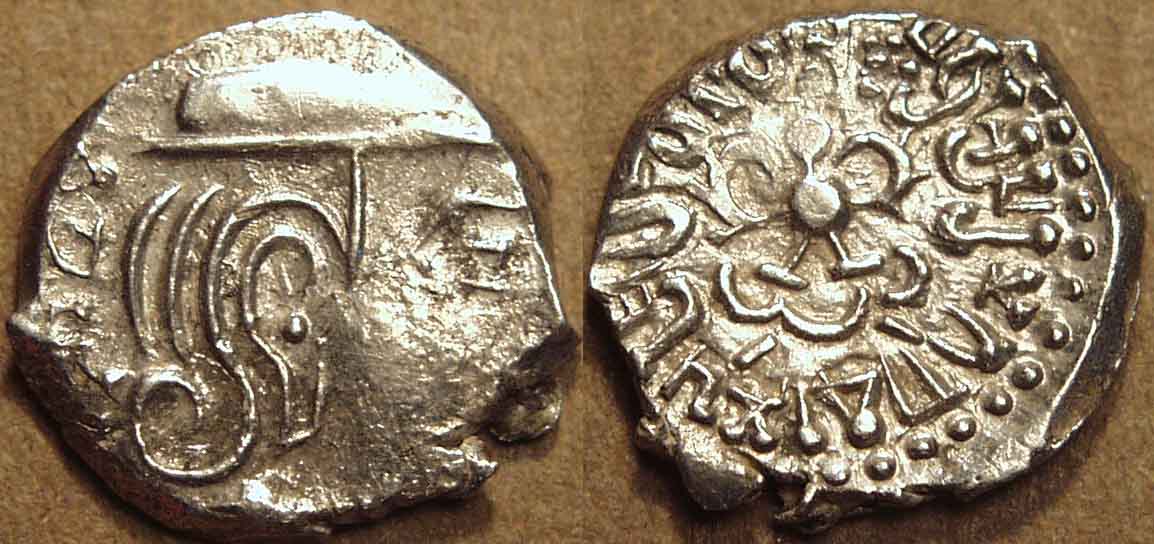
|
Kumaragupta I, silver drachma, c. 415-455
Weight: 2.04 gm, Diameter: 15-14 mm.
Head of king right, date 106 behind /
Stylized Garuda standing facing, with wings spread, sun above right,
Brāhmī legend around:
Paramabhāgavata Maharajadhiraja Sri Kumaragupta Mahendraditya
|
 |
On some rare coins of Kumaragupta, the Gupta era date can be seen behind the king's head. This coin is dated 106
(=426 CE). The next coin is dated 108.
|
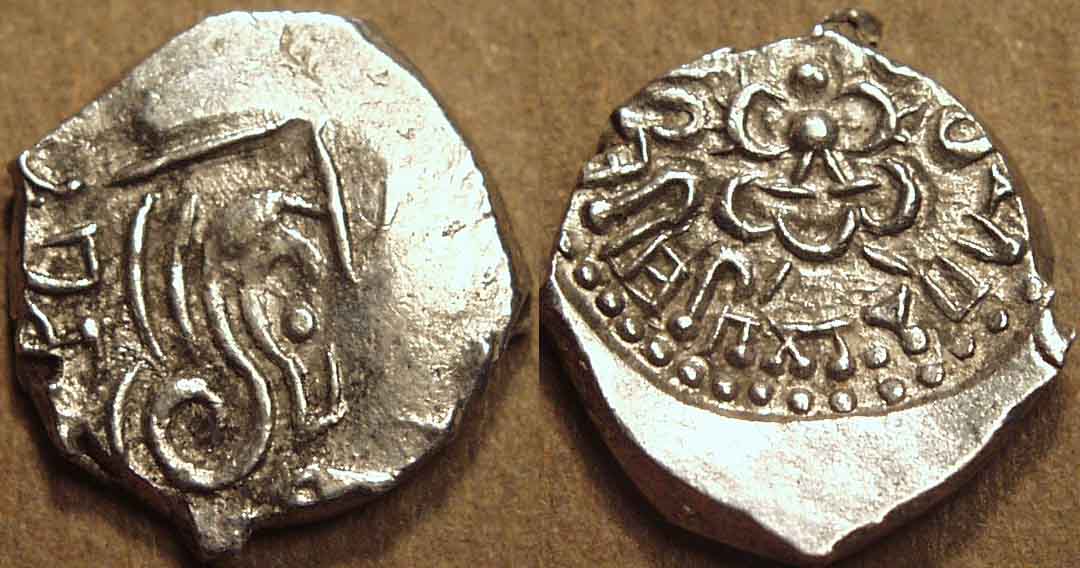
|
Kumaragupta I, silver drachma, c. 415-455
Weight: 2.13 gm, Diameter: 13 mm.
Head of king right, date 108 behind /
Stylized Garuda standing facing, with wings spread, sun above right,
Brāhmī legend around:
Paramabhāgavata Maharajadhiraja Sri Kumaragupta Mahendraditya
|
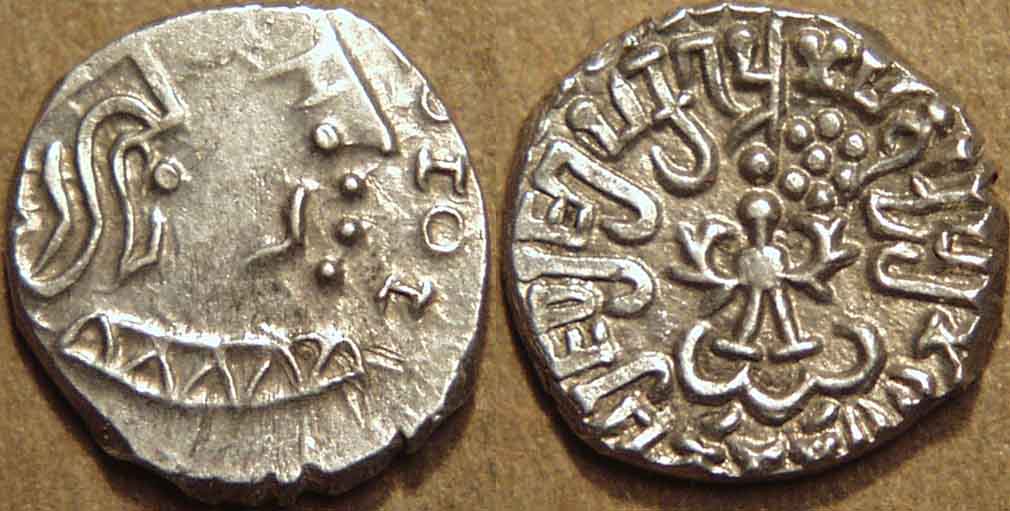
|
Kumaragupta I, silver drachma, c. 415-455
Weight: 2.10 gm, Diameter: 13 mm.
Head of king right /
Stylized Garuda standing facing, with wings spread, sun above right,
Brāhmī legend around:
Paramabhāgavata Maharajadhiraja Sri Pakagupta Mahendraditya
|
 |
A very unusual coin, in that the legend states the king's name not as kumaragupta but as Pakagupta!
Whether there is some significance to this name or it is simply a die-cutter's error is unknown.
|
 |
 |
 |
Madhyadesa type |

|
Kumaragupta I, silver drachma, c. 415-455
Weight: 2.15 gm, Diameter: 13-14 mm.
Head of king right /
Stylized peacock standing facing, with wings spread,
Brāhmī legend around:
Vijitavaniravanapati Kumaragupta divam jayati
|
 |
The Madhyadesa coins of Kumaragupta come from Uttar Pradesh. Their highly elegant portrait style reminds
me of the much later (and much admired) Kishangarh school of miniature painting. The reverse of these coins features a fan-tailed peacock; recall that the peacock is the
vahana of the deity Kartikeya (or Kumara).
|

|
Kumaragupta I, silver drachma, c. 415-455
Weight: 1.76 gm, Diameter: 14-15 mm.
Head of king right /
Stylized peacock standing facing, with wings spread,
Brāhmī legend around:
Vijitavaniravanapati Kumaragupta divam jayati
|
 |
The portrait style on this coin looks different, but it is not really. Instead, the coin serves as a warning to collectors.
The coin was actually very worn and presumably the facial features were not visible. An unscrupulous dealer tried to "enhance" the coin by carving in a face ... but in the
wrong style! Such heavily tooled coins are being seen in increasing numbers and I have recently written an article on these types of tooled forgeries, published in the
Journal of the Oriental Numismatic Society; the article can be seen here.
|

|
Kumaragupta I, silver drachma, c. 415-455
Weight: 1.90 gm, Diameter: 15 mm.
Head of king right /
Stylized peacock standing facing, with wings spread,
Brāhmī legend around:
Vijitavaniravanapati Kumaragupta divam jayati
|
 |
The Madhyadesa coins carry a date not behind the king's head (as on the Western style coins) but in front
of the king's face. The number 100 can be seen in front of the portrait on this coin.
|
 |
 |
 |
Lead coins |
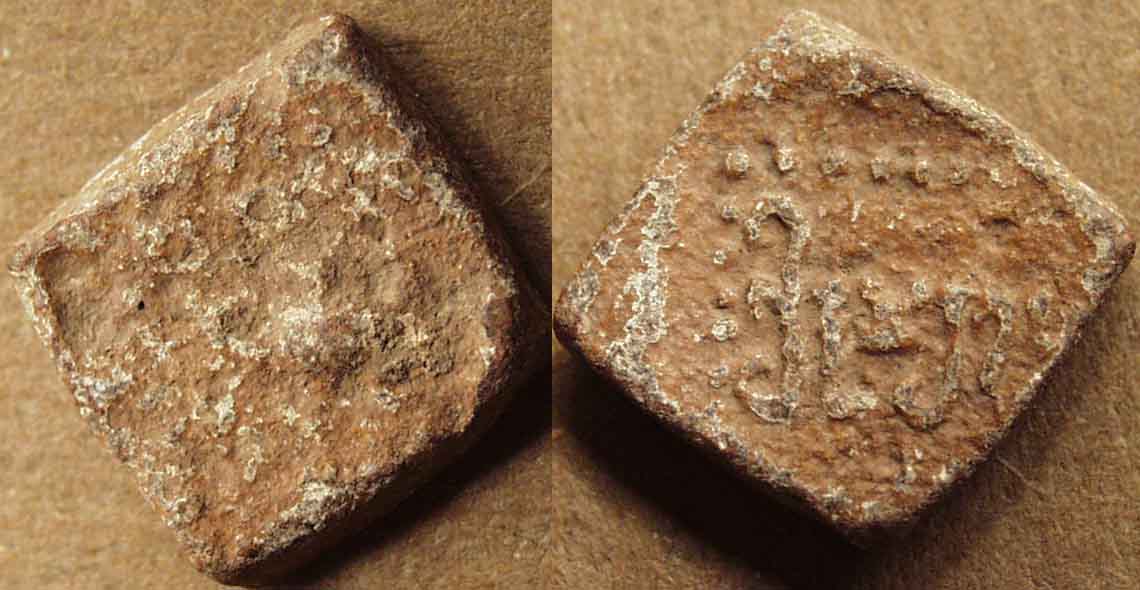
|
Kumaragupta I, c. 415-455, Lead unit
Weight: 5.82 gm., Dim: 14 x 14 mm., Die axis = 12 o'clock
Garuda standing facing, with wings outstretched /
Within dotted border: Brahmi legend: Sri Kumaragupta |

|
Kumaragupta I, c. 415-455, Lead fraction
Weight: 1.88 gm., Dim: 12 x 12 mm., Die axis = 12 o'clock
Garuda standing facing, with wings outstretched, dotted border around /
Within dotted border: Brahmi legend: Sri Kumaragu(pta) |
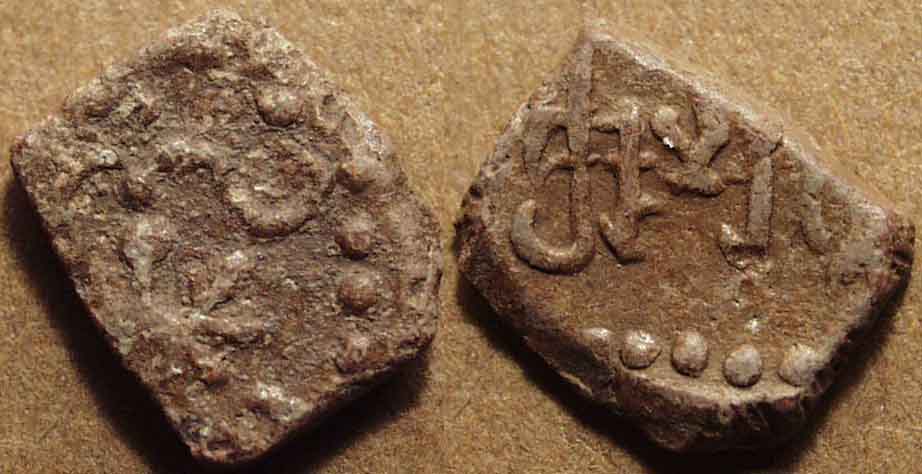
|
Kumaragupta I, c. 415-455, Lead unit (cut)
Weight: 2.41 gm., Dim: 11 x 13 mm., Die axis = 3 o'clock
Garuda standing facing, with wings outstretched, dotted border around /
Within dotted border: Brahmi legend: Sri Kumaragu(pta) |
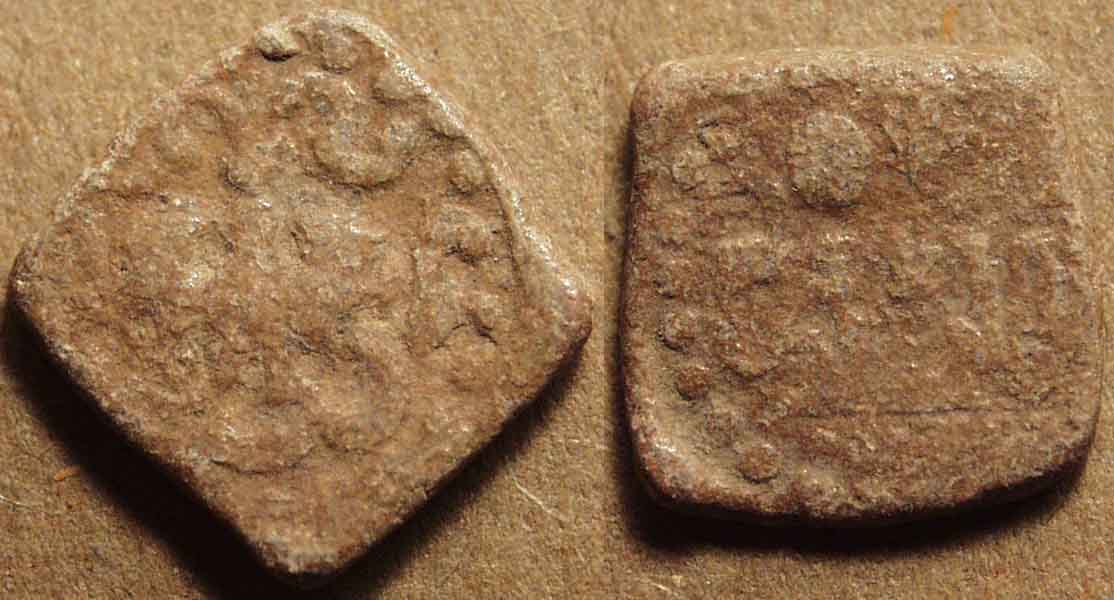
|
Kumaragupta I, c. 415-455, Lead unit
Weight: 4.47 gm., Dim: 16 x 15 mm., Die axis = 8 o'clock
Garuda standing facing, with wings outstretched, dotted border around /
Within dotted border: Brahmi legend: Sri Kumaragu(pta),
sun (and moon?) above |

|
Kumaragupta I, c. 415-455, Lead unit
Weight: 3.42 gm., Dim: 15 x 14 mm., Die axis = 10 o'clock
Garuda standing facing, with wings outstretched,
dotted border around, two suns above /
Within dotted border: Brahmi legend: Sri Kumaragupta |
|
|